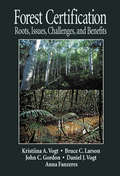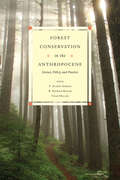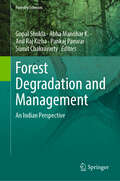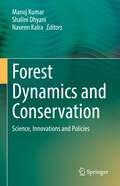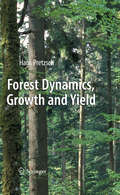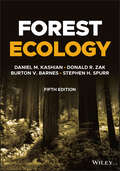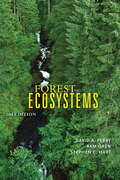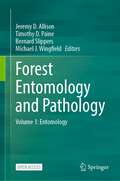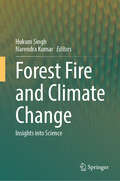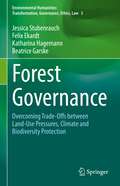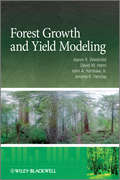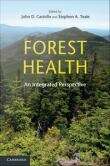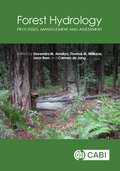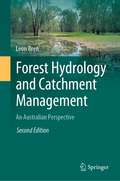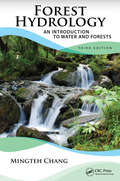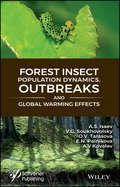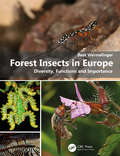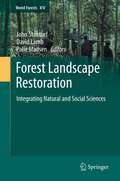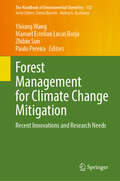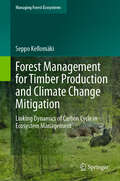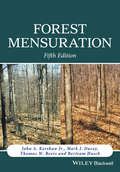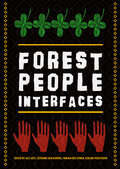- Table View
- List View
Forest Certification: Roots, Issues, Challenges, and Benefits
by Bruce C. Larson John C. Gordon Anna Fanzeres Daniel J. Vogt Kristiina A. VogtForest Certification examines the historical roots of forest certification, the factors that guide the development of protocols, the players involved, the factors determining the customers to be certified, and the benefits of certification. It covers terminology and issues that direct the structure of standards, the similarities between indicators of different human disturbances within the ecosystem/landscape, and certification standards. It documents the roles of human values in the development of assessment protocols and demonstrates how elements should be used to produce non-value based standards.
Forest Communities, Community Forests
by Elisa Adler Jonathan KuselFinding a Cafeteria of Possibility in an Array of Community Forestry Case Studies
Forest Conservation in the Anthropocene: Science, Policy, and Practice
by V. Alaric Sample, R. Patrick Bixler, and Char MillerForest Conservation in the Anthropocene provides thought-provoking insight into the ongoing environmental crises that climate change is generating and raises critical questions about how public and private land managers in North America will adapt to the climatological disruptions that are already transforming the ecological structures of these forests. In this pathbreaking anthology, a team of leading environmental researchers probes the central dilemmas that ecologists, forest land managers, state and federal agencies, and grassroots organizations are confronting—and will continue to confront—in the coming century. Each chapter examines strategies that are currently being tested across the country as scientists, citizen-scientists, policy makers, academics, and activists work to grasp their options and opportunities for a future that will be shaped by ongoing environmental upheaval. Successful adaptation to the challenges of climate change requires a transdisciplinary perspective. Forest Conservation in the Anthropocene provides a compelling set of arguments and case studies that underscores the need for innovative policies and energetic actions. Contributors: Craig D. Allen, Mark Anderson, Susan Beecher, R. Travis Belote, Timothy J. Brown, Anne A. Carlson, Tim Caro, Grace K. Charles, Dave Cleaves, Dena J. Clink, Ayesha Dinshaw, R. Kasten Dumroese, Jonas Epstein, Alexander M. Evans, Todd Gartner, Jessica E. Halofsky, Nels Johnson, Linda A. Joyce, Paige Lewis, Laura Falk McCarthy, Heather McGray, Constance I. Millar, James Mulligan, Chadwick Dearing, David L. Peterson, Will Price, Janine M. Rice, Jason Riggio, Tania Schoennagel, Mark L. Shaffer, Curt Stager, Scott L. Stephens, Thomas W. Swetnam, Gary M. Tabor, Christopher Topik, Monica G. Turner, Thomas T. Veblen, Alexandra M. Weill, Anthony L. Westerling, Carolyn Whitesell, Mary I. Williams
Forest Degradation and Management: An Indian Perspective (Forestry Sciences #87)
by Gopal Shukla Sumit Chakravarty Pankaj Panwar Abha Manohar K. Anil Raj KizhaForest Degradation and Management - An Indian Perspective provides an overview of the dynamics and challenges surrounding forest degradation in India. It reveals the harmful impacts of human activity on natural resources, ecosystems, and communities, and emphasizes the urgent need for sustainable forest management practices. The book is divided into four parts, each offering a different perspective on forest degradation. Part I presents an overview of forest degradation in India, including a comparative analysis of assessment tools. Part II explores the ecological impacts of forest degradation on ecosystems. Part III is dedicated to societal aspects, examining the consequences of human activity such as cultivation, eco-tourism, resource utilization, and deforestation, while also analyzing the impact of forest degradation on forest-dependent communities. Part IV focuses on mitigation strategies, highlighting the role of protected areas, governance, policies, and participatory approaches. This volume within the book series Forestry Sciences is an invaluable resource for students, researchers, policymakers, and conservationists seeking to tackle the complex challenges of forest degradation. It provides knowledge and practical insights to inform decision-making processes, guide sustainable forest management strategies, and promote responsible land use practices.
Forest Dynamics and Conservation: Science, Innovations and Policies
by Manoj Kumar Shalini Dhyani Naveen KalraThis book unveils forestry science and its policy and management that connect past and present understanding of forests. The aggregated knowledge is presented to cover the approaches adopted in studying forest structure, its growth, functioning, and degradation, especially in the context of the surrounding environment. The application of advance computation, instrumentation, and modelling has been elaborated in various chapters.Forest ecosystems are rapidly changing due to forest fires, deforestation, urbanization, climate change, and other natural and anthropogenic drivers. Understanding the dynamics of forest ecosystems requires contemporary methods and measures, utilizing modern tools and big data for developing effective conservation plans. The book also covers discussion on policies for sustainable forestry, agroforestry, environmental governance, socio-ecology, nature-based solutions, and management implication. It is suitable for a wide range of readers working in the field of scientific forestry, policy making, and forest management. In addition, it is a useful material for postgraduate and research students of forestry sciences.
Forest Dynamics, Growth and Yield
by Hans PretzschThe aim of this book is to improve the understanding of forest dynamics and the sustainable management of forest ecosystems. How do tree crowns, trees or entire forest stands respond to thinning in the long term? What effect do tree species mixtures and multi-layering have on the productivity and stability of trees, stands or forest enterprises? How do tree and stand growth respond to stress factors such as climate change or air pollution? Furthermore, in the event that one has acquired knowledge about the effects of thinning, mixture and stress, how can one make that knowledge applicable to decision-making in forestry practice? The experimental designs, analytical methods, general relationships and models for answering questions of this kind are the focus of this book. Given the structures dealt with, which range from plant organs to the tree, stand and enterprise levels, and the processes analysed in a time frame of days or months to decades or even centuries, this book is directed at all readers interested in trees, forest stands and forest ecosystems. This work has been compiled for students, scientists, lecturers, forest planners, forest managers, and consultants.
Forest Ecology
by Donald R. Zak Burton V. Barnes Stephen H. Spurr Daniel M. KashianFOREST ECOLOGY Authoritative resource covering traditional plant ecology topics and contemporary components such as climate change, invasive species, ecosystem services, and more Forest Ecology provides comprehensive coverage of the field, focusing on traditional plant ecology topics of tree structure and growth, regeneration, effects of light and temperature on tree physiology, forest communities, succession, and diversity. The work also reviews abiotic factors of light, temperature, physiography (landforms and topography), soil, and disturbance (especially fire), and provides coverage of ecosystem-level topics including carbon storage and balance, nutrient cycling, and forest ecosystem productivity. The 5th edition of Forest Ecology retains the readability and accessibility of the previous editions and includes important additional topical material that has surfaced in the field. All topics are approached with a landscape ecosystem or geo-ecological view, which places biota (organisms and communities) in context as integral parts of whole ecosystems that also include air (atmosphere and climate), topography, soil, and water. As such, the book fills a niche utilized by no other forest ecology text on the market, helping students and researchers consider whole ecosystems at multiple scales. Sample topics covered in Forest Ecology include: Contemporary components of forest ecology, including climate change, invasive species, diversity, ecological forestry, landscape ecology, and ecosystem services. Characteristics of physiography important for forest ecosystems, including its effects on microclimate, disturbance, soil, and vegetation. Genetic diversity of woody plants and genecological differentiation of tree species, including the importance of hybridization, polyploidy, and epigenetics. Site quality estimation using tree height and ground flora, and multiple-factor approaches to forest site and ecosystem classification and mapping. Forest Ecology is a highly accessible text for students, but it also serves as an excellent reference for academics. In addition, practitioners of forest ecology can also harness the information within to gain better insight into the field for practical application of concepts.
Forest Ecosystems
by Ram Oren David A. Perry Stephen C. Hart2009 Outstanding Academic Title, ChoiceThis acclaimed textbook is the most comprehensive available in the field of forest ecology. Designed for advanced students of forest science, ecology, and environmental studies, it is also an essential reference for forest ecologists, foresters, and land managers. The authors provide an inclusive survey of boreal, temperate, and tropical forests with an emphasis on ecological concepts across scales that range from global to landscape to microscopic. Situating forests in the context of larger landscapes, they reveal the complex patterns and processes observed in tree-dominated habitats. The updated and expanded second edition covers • Conservation• Ecosystem services • Climate change• Vegetation classification• Disturbance• Species interactions• Self-thinning• Genetics• Soil influences• Productivity• Biogeochemical cycling• Mineralization• Effects of herbivory• Ecosystem stability
Forest Entomology and Pathology: Volume 1: Entomology
by Bernard Slippers Jeremy D. Allison Timothy D. Paine Michael J. WingfieldThis open access book will provide an introduction to forest entomology, the principles and techniques of forest insect pest management, the different forest insect guilds/feeding groups, and relevant forest insect pest management case studies. In addition to covering 30% of the earth, forest ecosystems provide numerous timber and non-timber products that affect our daily lives and recreational opportunities, habitat for diverse animal communities, watershed protection, play critical roles in the water cycle, and mitigate soil erosion and global warming. In addition to being the most abundant organisms in forest ecosystems, insects perform numerous functions in forests, many of which are beneficial and critical to forest health. Conversely, some insects damage and/or kill trees and reduce the capacity of forests to provide desired ecosystem services. The target audience of this book is upper-level undergraduate and graduate students and professionals interested in forest health and entomology.
Forest Entomology: A Global Perspective
by William CieslaInsects are the most abundant and diverse organisms that inhabit our planet and are found in all the world’s forest ecosystems. Many feed and/or breed on parts of trees. Some perform important functions, such as pollination or break-down of dead vegetation. Others weaken, deform or kill trees, and compete with humans for the many goods and services that trees and forests provide. Forest Entomology: A Global Perspective examines forest insects in a global context and reviews their dynamics, interactions with humans and methods for monitoring and management of species that damage forests. Also provided are 235 profiles of forest insects, worldwide. A series of tables provides summaries of the distribution and hosts of many more species. Included are those that damage forests, others that are simply curiosities and some that are beneficial. This book is designed as a reference for students, practicing foresters and forest health specialists, especially for those who work internationally or are concerned with species that have the potential to expand their ranges via international trade, travel or environmental changes.
Forest Fire and Climate Change: Insights into Science
by Narendra Kumar Hukum SinghThis book delves deep into the complex relationship between forest fires and climate change by thoroughly exploring the scientific foundations, ecological consequences, and global implications of forest fires in the climate change scenario. The book begins by elucidating the fundamentals of climate change, offering readers a clear understanding of the mechanisms driving global warming. It then seamlessly transitions into an in-depth analysis of how rising temperatures, prolonged droughts, and altered precipitation patterns exacerbate forest fires. The book demonstrates how wildfires have evolved from natural phenomena into destructive, uncontrollable forces, threatening ecosystems, communities, and economies through detailed case studies and data-driven insights. This book emphasizes solutions and mitigation strategies for forest fires under the climate change scenario. It explores innovative approaches to managing and preventing wildfires, from controlled burns to advanced fire prediction models. It also underscores the importance of global cooperation in reducing greenhouse gas emissions to mitigate the impacts of climate change on forest fires. This book serves as a vital resource for policymakers, scientists, and anyone interested in the intersection of climate change and wildfires. It empowers readers with the knowledge to address this pressing global issue and highlights the urgency of taking action to protect forests and mitigate climate change's devastating effects.
Forest Governance: Overcoming Trade-Offs between Land-Use Pressures, Climate and Biodiversity Protection (Volume 3) (Environmental Humanities: Transformation, Governance, Ethics, Law)
by Katharina Hagemann Felix Ekardt Jessica Stubenrauch Beatrice GarskeThis book analyses and develops overarching concepts for forest policy and forest governance and includes a detailed investigation into the historical discussion on forests. It examines opportunities and limits for negative emissions in a sector that – like peatlands – appears significantly less ambivalent compared to highly technical large-scale forms of climate geoengineering. The analysis shows that the binding climate and biodiversity targets under international law are much more ambitious than most people assume. Measured against that, the volume critically reviews the potentials of afforestation and reforestation for climate mitigation, which is often presented as the new saviour to fulfil the commitments of the Paris Agreement and to reach climate neutrality in the future. It becomes clear that ultimately only biodiverse and thus resilient forests can function as a carbon sink in the long term. The volume shows that the existing European and international forest governance approaches fail to comply with these targets and insights. Furthermore, the book develops a bundle of policy measures. Quantity governance systems for livestock farming, fossil fuels and similar drivers of deforestations represent the most important approach. They are most effective when not directly targeting forests due to their heterogeneity but central damaging factors. With regard to the dominant regulatory and subsidy-based governance for forests we show that it remains necessary to supplement these quantity governance systems with certain easily graspable and thus controllable regulatory and subsidy regulations such as a regulatory protection of old-growth forests with almost no exceptions; extension of the livestock-to-land-ratio established in organic farming to all farming; far-reaching restriction of bioenergy use to certain residues flanked by import bans; and a national and international complete conversion of all agricultural and forest subsidies to “public money for public services” to promote nature conservation and afforestation in addition to the quantity control systems.
Forest Growth and Yield Modeling
by Aaron R. Weiskittel John A. Kershaw Jr. Jerome K. Vanclay David W. HannForest Growth and Yield Modeling synthesizes current scientific literature and provides insights in how models are constructed. Giving suggestions for future developments, and outlining keys for successful implementation of models the book provides a thorough and up-to-date, single source reference for students, researchers and practitioners requiring a current digest of research and methods in the field.The book describes current modelling approaches for predicting forest growth and yield and explores the components that comprise the various modelling approaches. It provides the reader with the tools for evaluating and calibrating growth and yield models and outlines the steps necessary for developing a forest growth and yield model.Single source reference providing an evaluation and synthesis of current scientific literatureDetailed descriptions of example modelsCovers statistical techniques used in forest model constructionAccessible, reader-friendly style
Forest Health: An Integrated Perspective
by John D. Castello Stephen A. TealeForest Health: An Integrated Perspective is the first book to define an ecologically rational, conceptual framework that unifies and integrates the many sub-disciplines that comprise the science of forest health and protection. This new global approach applies to boreal, temperate, tropical, natural, managed, even-aged, uneven-aged and urban forests, as well as plantations. Readers of the text can use real datasets to assess the sustainability of four forests around the world. Datasets for the case studies are at www.cambridge.org/9780521766692, and the text provides stepwise instructions for performing the calculations in Microsoft Excel. Readers can follow along as the editors perform the same calculations and interpret the results. Elevating forest health from a fuzzy concept to an ecologically sound paradigm, this is essential reading for undergraduate and graduate students and professionals interested in forest health, protection, entomology, pathology and ecology.
Forest Hydrology
by Devendra M. Amatya Thomas M. Williams Leon Bren Carmen JongForests cover approximately 26% of the world's land surface area and represent a distinct biotic community. They interact with water and soil in a variety of ways, providing canopy surfaces which trap precipitation and allow evaporation back into the atmosphere, thus regulating how much water reaches the forest floor as through fall, as well as pull water from the soil for transpiration. The discipline "forest hydrology" has been developed throughout the 20th century. During that time human intervention in natural landscapes has increased, and land use and management practices have intensified. This book: - Presents cutting edge thinking and assessments in forest hydrology across all latitudes and terrains, including state-of-the-art modelling techniques and methodologies - Describes the latest challenges facing forest hydrology, such as increased occurrence of disturbance, due to extreme floods, drought, disease, and fire, potentially caused by climate change - Is written by an internationally renowned team of scientists, engineers, and managers to give a well-rounded review of the subject The book will be useful for graduate students, professionals, land managers, practitioners, and researchers with a good understanding of the basic principles of hydrology and hydrologic processes.
Forest Hydrology and Biogeochemistry
by Darryl Carlyle-Moses Delphis F. Levia Tadashi TanakaThis international rigorously peer-reviewed volume critically synthesizes current knowledge in forest hydrology and biogeochemistry. It is a one-stop comprehensive reference tool for researchers and practitioners in the fields of hydrology, biogeoscience, ecology, forestry, boundary-layer meteorology, and geography. Following an introductory chapter tracing the historical roots of the subject, the book is divided into the following main sections: · Sampling and Novel Approaches · Forest Hydrology and Biogeochemistry by Ecoregion and Forest Type · Hydrologic and Biogeochemical Fluxes from the Canopy to the Phreatic Surface · Hydrologic and Biogeochemical Fluxes in Forest Ecosystems: Effects of Time, Stressors, and Humans The volume concludes with a final chapter that reflects on the current state of knowledge and identifies some areas in need of further research.
Forest Hydrology and Catchment Management: An Australian Perspective
by Leon BrenThis book provides scientific evidence to underline the notion that forests offer the most reliable water catchments in the natural environment. The unique Australian ecosystem provides valuable information on the water yields and hydro-ecology of forests. Insights can be transferred to other climate zones and conditions. In this second edition, the author puts a particular focus on the most prominent challenges of our time, in relation to water management. Ground salinity, climate change, and droughts have all been newly added to this updated edition. One of the most important concepts is highlighting the accumulated contribution of smaller catchments and minor streams. Finally, readers will also get information on the economic dimension of water management. With its incisive, disciplined, and quantitative (and occasionally humorous) approach, this book helps scientists, students, and regulators to understand water-driven conflicts and offers guidance on management.
Forest Hydrology: An Introduction to Water and Forests, Third Edition
by Mingteh ChangDue to its height, density, and thickness of crown canopy; fluffy forest floor; large root system; and horizontal distribution; forest is the most distinguished type of vegetation on the earth. In the U.S., forests occupy about 30 percent of the total territory. Yet this 30 percent of land area produces about 60 percent of total surface runoff, the
Forest Insect Population Dynamics, Outbreaks, And Global Warming Effects
by A. S. Isaev A. V. Kovalev E. N. Palnikova O. V. Tarasova V. G. SoukhovolskyResearch in insect population dynamics is important for more reasons than just protecting forest communities. Insect populations are among the main ecological units included in the analysis of stability of ecological systems. Moreover, it is convenient to test new methods of analyzing population and community stability on the insect-related data, as by now ecologists and entomologists have accumulated large amounts of such data. In this book, the authors analyze population dynamics of quite a narrow group of insects – forest defoliators. It is hoped that the methods proposed herein for the analysis of population dynamics of these species may be useful and effective for analyzing population dynamics of other animal species and their effects and role in global warming. What can insects tell us about our environment and our ever-changing climate? It is through studies like this one that these important answers can be obtained, along with data on the insects and their behaviors themselves. The authors present new theories on modeling and data accumulation, using cutting-edge processes never before published for such a wide audience. This volume presents the state-of-the-art in the science, and it is an essential piece of any entomologist’s and forest engineer’s library.
Forest Insects in Europe: Diversity, Functions and Importance
by Beat WermelingerForest insects play important roles ecologically and economically. They pollinate plants, decompose dead plant and animal tissue, provide food for vertebrates, regulate pest organisms and shape entire landscapes. Some are considered pests, while others provide usable products. Introduced species may become invasive, while the survival of others is threatened. Forest Insects in Europe: Diversity, Functions and Importance has been written not only with professional entomologists in mind, but also for nature lovers generally. The descriptions of the various roles insects play in forest ecosystems are intended to be easily comprehensible, but still scientific. The book is richly illustrated with attractive photos and contains 580 fascinating colour images of more than 300 different insect and spider species. The German edition was awarded the Prix Moulines by the Swiss Entomological Society in 2019.
Forest Landscape Restoration
by David Lamb John Stanturf Palle MadsenRestoration ecology, as a scientific discipline, developed from practitioners' efforts to restore degraded land, with interest also coming from applied ecologists attracted by the potential for restoration projects to apply and/or test developing theories on ecosystem development. Since then, forest landscape restoration (FLR) has emerged as a practical approach to forest restoration particularly in developing countries, where an approach which is both large-scale and focuses on meeting human needs is required. Yet despite increased investigation into both the biological and social aspects of FLR, there has so far been little success in systematically integrating these two complementary strands. Bringing experts in landscape studies, natural resource management and forest restoration, together with those experienced in conflict management, environmental economics and urban studies, this book bridges that gap to define the nature and potential of FLR as a truly multidisciplinary approach to a global environmental problem. The book will provide a valuable reference to graduate students and researchers interested in ecological restoration, forest ecology and management, as well as to professionals in environmental restoration, natural resource management, conservation, and environmental policy.
Forest Management for Climate Change Mitigation: Recent Innovations and Research Needs (The Handbook of Environmental Chemistry #132)
by Paulo Pereira Yixiang Wang Manuel Esteban Lucas Borja Zhibin SunThis book reviews the most recent research on soil, vegetation, and ecosystems within forestry landscapes under the pressures of climate change. It also explores the interplay between climate change, forest ecology, and human interventions. Covering a diverse array of topics such as carbon sequestration, wildfire impacts, soil biogeochemistry, and methane emissions, the book incorporates scientific research and management strategies to provide a holistic understanding of the challenges and opportunities for forest management amidst climate change. In this book, readers will find the most up-to-date afforestation and forest management techniques for controlling greenhouse gas (GHG) emissions and carbon sequestration in the forestry system. The readers of this book will gain a new perspective on forests by learning about new forestry techniques, forest vegetation change, natural and artificial disturbances, soil greenhouse gases, and soil chemistry, all while emphasizing the critical relationship between Environmental Chemistry and Forestry. Focusing on the practices of the Asia-Pacific Network for Sustainable Forest Management and Rehabilitation (APFNet) Projects, the book offers insights into practical approaches and solutions for addressing climate change within forest ecosystems and provides evidence-based recommendations for sustainable forest management and adaptation strategies. This unique volume, which includes contributions from respected scholars, emphasizes the importance of interdisciplinary collaboration in addressing the complex challenges posed by climate change in forest ecosystems. It also aims to raise awareness among forestry researchers, officials, and policymakers about the growing importance of forest ecosystems as a result of global climate change.
Forest Management for Timber Production and Climate Change Mitigation: Linking Dynamics of Carbon Cycle in Ecosystem Management (Managing Forest Ecosystems #44)
by Seppo KellomäkiThis book introduces the complex world of carbon dynamics within forest ecosystems, particularly in boreal zones, while also incorporating findings from selected temperate areas. It explores how these dynamics are influenced by management strategies and operations, providing a comprehensive understanding of how forests can be managed to enhance carbon uptake and thus, mitigate climate change. Divided into five parts, the volume begins by addressing the characteristics of global and boreal forests and their contribution to carbon storage. The following sections explore carbon dynamics in both natural and managed forests, including their impact on forest succession. The text also examines how management practices affect carbon dynamics, tree growth, and carbon stocks. Strategies to mitigate climate change through forest management, including the management of soil carbon and reforestation efforts are discussed. Finally, topics such as pre-commercial management, commercial thinning, and forest fertilization and their roles in managing boreal forest ecosystems for carbon sequestration and climate benefits are addressed. Aimed at professionals, researchers, and students in forestry, environmental science, and climate change studies, this book provides valuable insights into developing management strategies that enhance carbon uptake and accumulation in forest ecosystems. Readers will gain a comprehensive understanding of how forest management can contribute to climate change mitigation. It is an essential resource for anyone interested in sustainable forestry practices.
Forest Mensuration
by John A. Kershaw Jr. Thomas W. Beers Mark J. Ducey Bertram HuschForest mensuration - the science of measurement applied to forest vegetation and forest products - holds value for basic ecology as well as sustainable forest management. As demands on the world's forests have grown, scientists and professionals are increasingly called on to quantify forest composition, structure, and the goods and services forests provide. Grounded in geometry, sampling theory, and ecology as well as practical field experience, forest mensuration offers opportunities for creative problem solving and critical thinking. This fifth edition of the classic volume, Forest Mensuration, includes coverage of traditional and emerging topics, with attention to SI and Imperial units throughout. The book has been reorganised from the fourth edition to better integrate non-timber and ecological aspects of forest mensuration at the tree, stand, forest, and landscape scales throughout. The new edition includes new chapters that specifically address the integration of remotely sensed data in the forest inventory process, and inventory methods for dead and downed wood. One unifying theme, not only for traditional forestry but for the non-timber inventory and for remote sensing, is the use of covariates to make sampling more efficient and spatially explicit. This is introduced in the introductory chapter on statistics and the chapter on sampling designs has been restructured to highlight this approach and lay the foundation for further learning. New examples will be developed throughout the textbook with an emphasis on current issues and international practice. Students in applied forestry programs will find ample coverage of forest products and timber inventory, while expanded material on biodiversity, biomass and carbon inventory, downed dead wood, and the growing role of remote sensing in forest assessment will be valuable to a broader audience in applied ecology. About the AuthorsJohn A. Kershaw, Jr. Faculty of Forestry and Environmental Management, University of New Brunswick, New Brunswick, CanadaMark J. Ducey, Department of Natural Resources and the Environment, University of New Hampshire, USAThomas W. Beers, Emeritus Professor of Forestry, Purdue University, USABertram Husch, former Forestry Consultant at INFORA Estudios Ltda. in Santiago, Chile, and former Forest Mensurationist, FAO
Forest People Interfaces
by Bas Arts Séverine Van Bommel Gerard Verschoor Mirjam Ros-TonenThis book aims at both academics and professionals in the field of forest-people interfaces. It takes the reader on a journey through four major themes that have emerged since the initiation of 'social forestry' in the 1970s: non-timber forest products and agroforestry; community-based natural resource management; biocultural diversity; and forest governance. In so doing, the books offers a comprehensive and current review on social issues related to forests that other, more specialized publications, lack. It is also theory-rich, offering both mainstream and critical perspectives, and presents up-to-date empirical materials. Reviewing these four major research themes, the main conclusion of the book is that naïve optimism associated with forest-people interfaces should be tempered. The chapters show that economic development, political empowerment and environmental aims are not easily integrated. Hence local landscapes and communities are not as 'makeable' as is often assumed. Events that take place on other scales might intervene; local communities might not implement policies locally; and governance practices might empower governments more than communities. This all shows that we should go beyond community-based ideas and ideals, and look at practices on the ground.
